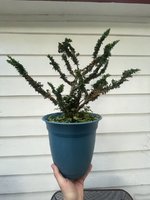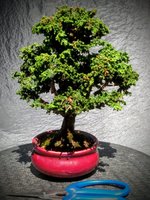You are using an out of date browser. It may not display this or other websites correctly.
You should upgrade or use an alternative browser.
You should upgrade or use an alternative browser.
Wulfskaar's Chirimen Hinoki Cypress (Chamaecyparis obtusa 'Chirimen')
- Thread starter Wulfskaar
- Start date
Cruiser
Chumono
These are strange trees. It seems like a mini alpine form resides in those tentacles of growth, yet I haven’t seen it brought out.
Mine gets full-partial sun depending on time of year. “Normal” amounts of watering. It does seem to tolerate excess water and accidental droughts. Occasional fish emulsion gets applied in the summer.
Older globs of foliage seem to randomly go brown and crispy at certain times of year, even with plenty of sun. It also appears that areas of foliage develop unsightly masses of pollen cones that when finished come off leaving a bare stem.
I give mine creative freedom to do its thing and have stopped trying to style it. I’ll plant it one day in a conspicuous place so that passerbys can comment on its oddness.

The cones.

New growth on older wood? Not sure.

Mine gets full-partial sun depending on time of year. “Normal” amounts of watering. It does seem to tolerate excess water and accidental droughts. Occasional fish emulsion gets applied in the summer.
Older globs of foliage seem to randomly go brown and crispy at certain times of year, even with plenty of sun. It also appears that areas of foliage develop unsightly masses of pollen cones that when finished come off leaving a bare stem.
I give mine creative freedom to do its thing and have stopped trying to style it. I’ll plant it one day in a conspicuous place so that passerbys can comment on its oddness.

The cones.

New growth on older wood? Not sure.

Last edited:
0soyoung
Imperial Masterpiece
Wulfskaar
Omono
These are strange trees. It seems like a mini alpine form resides in those tentacles of growth, yet I haven’t seen it brought out.
Mine gets full-partial sun depending on time of year. “Normal” amounts of watering. It does seem to tolerate excess water and accidental droughts. Occasional fish emulsion gets applied in the summer.
Older globs of foliage seem to randomly go brown and crispy at certain times of year, even with plenty of sun. It also appears that areas of foliage develop unsightly masses of pollen cones that when finished come off leaving a bare stem.
Yeah, I have no idea where to go with it, so maybe I'll make it just as weird as possible to bring out it's odd characteristics.
Yamabudoudanshi
Shohin
This looks like a regular old sekka hinoki to me. Not sure what the 'chirimen' variety is all about as I've never encountered that name.
I'm developing a few clumps from utherwise uninteresting stock. Where you get a burl with a bunch of branches you can bend all of them upward and air layer the base. It's also a good idea to actually twist the truncks if they're not too thick. Doing this gives you branches in all directions rather than the 3 and 6 poisitions they tend to develop at. It also effectively shortens the distance between the branches as twisting the trunks compresses them like springs.
This guy develops the best sekka hinoki as far as I'm concerned.
I'm developing a few clumps from utherwise uninteresting stock. Where you get a burl with a bunch of branches you can bend all of them upward and air layer the base. It's also a good idea to actually twist the truncks if they're not too thick. Doing this gives you branches in all directions rather than the 3 and 6 poisitions they tend to develop at. It also effectively shortens the distance between the branches as twisting the trunks compresses them like springs.
This guy develops the best sekka hinoki as far as I'm concerned.
hardtimes
Mame
my local nursery sells these. hope their page can help you

 houseofbonsai.com
houseofbonsai.com

Dwarf Chirimen Hinoki Cypress (Chamaecyparis obtusa 'Chirimen') Pre-Bonsai Tree - 4 Inch
House of Bonsai - The Largest Bonsai Nursery in California - Growing Bonsai for the Public Since 1990
I am no expert but I strongly believe that Chirimen and Sekka are the same cultivar, or at least very similar...and can be treated similarly. They root from cuttings very easily. They wire well and can make interesting trees. Typically I see them done as small trees...given the tiny foliage.
Yamabudoudanshi
Shohin
Very few hits in Japanese. I think it's just another name for the regular sekka hinoki. There are other weird cultivars out there like the spiked-looking (male?) variety, which I can't remember the name of right now (something like Hibari), as well as a yellow one.my local nursery sells these. hope their page can help you

Dwarf Chirimen Hinoki Cypress (Chamaecyparis obtusa 'Chirimen') Pre-Bonsai Tree - 4 Inch
House of Bonsai - The Largest Bonsai Nursery in California - Growing Bonsai for the Public Since 1990houseofbonsai.com
For comparison sake, here's one of my air layers.
Totally agree with the "strange tree" comment. I have a few of differing sizes and I'm trying to figure out how to move forward with them. For now, I'm just letting them grow...These are strange trees. It seems like a mini alpine form resides in those tentacles of growth, yet I haven’t seen it brought out.
Mine gets full-partial sun depending on time of year. “Normal” amounts of watering. It does seem to tolerate excess water and accidental droughts. Occasional fish emulsion gets applied in the summer.
Older globs of foliage seem to randomly go brown and crispy at certain times of year, even with plenty of sun. It also appears that areas of foliage develop unsightly masses of pollen cones that when finished come off leaving a bare stem.
I give mine creative freedom to do its thing and have stopped trying to style it. I’ll plant it one day in a conspicuous place so that passerbys can comment on its oddness.
View attachment 514368
The cones.
View attachment 514369
New growth on older wood? Not sure.
View attachment 514370
Wulfskaar
Omono
The more I look at mine, the more I wonder what the heck I'm going to do with it!Totally agree with the "strange tree" comment. I have a few of differing sizes and I'm trying to figure out how to move forward with them. For now, I'm just letting them grow...
John P.
Chumono
Wulfskaar
Omono
Yeah that's definitely an option.luckily you have some green growth near the bottom. You could try to layer the straight part off and build taper and interest down low?
View attachment 517749
ShimpakuBonsai
Chumono
I've posted about chirimen and sekka hinoki in several topics before and I also think they are the same variety of chamaecyparis obtusa.
I have bought "original" sekka cutting from Crespi bonsai in Italy and I have bought chirimen from garden centers in the Netherlands and Germany.
They look and grow the same and after about 3 years I'm still figuring out how to deal with them.
I have made quite a few cuttings and they air layer very easy but it's not easy to get them where I want them to be.
The only thing I can't explain is why it looks like it is called sekka in Japan and chirimen in the rest of the world.
You can come across the name chirimen with other species of trees aswell (for example chirimen kazura).
There is also another variety called sekka miyabi which has a different kind of foliage.
I've been looking for this variety in Europe but I can't find it unfortunally.
See this topic for more info about sekka miyabi.
I have bought "original" sekka cutting from Crespi bonsai in Italy and I have bought chirimen from garden centers in the Netherlands and Germany.
They look and grow the same and after about 3 years I'm still figuring out how to deal with them.
I have made quite a few cuttings and they air layer very easy but it's not easy to get them where I want them to be.
The only thing I can't explain is why it looks like it is called sekka in Japan and chirimen in the rest of the world.
You can come across the name chirimen with other species of trees aswell (for example chirimen kazura).
There is also another variety called sekka miyabi which has a different kind of foliage.
I've been looking for this variety in Europe but I can't find it unfortunally.
See this topic for more info about sekka miyabi.
Wulfskaar
Omono
Thanks for the information!I've posted about chirimen and sekka hinoki in several topics before and I also think they are the same variety of chamaecyparis obtusa.
I have bought "original" sekka cutting from Crespi bonsai in Italy and I have bought chirimen from garden centers in the Netherlands and Germany.
They look and grow the same and after about 3 years I'm still figuring out how to deal with them.
I have made quite a few cuttings and they air layer very easy but it's not easy to get them where I want them to be.
The only thing I can't explain is why it looks like it is called sekka in Japan and chirimen in the rest of the world.
You can come across the name chirimen with other species of trees aswell (for example chirimen kazura).
There is also another variety called sekka miyabi which has a different kind of foliage.
I've been looking for this variety in Europe but I can't find it unfortunally.
See this topic for more info about sekka miyabi.
Just last night I watched this video from @Eric Schrader
It should be fun experimenting with mine. I will probably start with an air layer in spring.
Wulfskaar
Omono
I have gotten a little inspiration from this Nigel Saunders video. 
Wulfskaar
Omono
Similar threads
- Replies
- 3
- Views
- 1K




